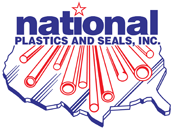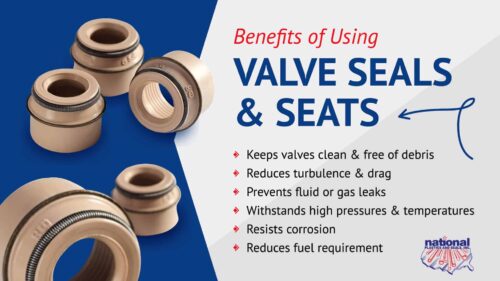Valve Seals & Seats
National Plastics & Seals, Inc. is a leading manufacturer of valve seals and seats. Our products meet automotive, marine, industrial, and aerospace requirements.
These seals and seats help to keep the valves clean and free of debris and prevent damage to other parts and systems. Additionally, they can help improve the valves’ efficiency by reducing turbulence and drag.
How Valve Seals Work
A valve seal is a type of mechanical seal that is used to prevent the leakage of fluid or gas from a valve. It does this by creating a tight seal between the moving parts of the valve and the stationary parts.
A valve seat is the part of a valve against which the seal rests. The seat is typically made from a hard, wear-resistant material, to withstand the high pressures and temperatures in valves.
Valve seals and seats are essential components in various industries, such as oil and gas, power generation, and water treatment. In these industries, valves control the flow of fluids or gases. If a valve is not sealed correctly, the fluid or gas can leak out, leading to costly repairs or safety hazards.
Over time, valve seals and seats can wear out due to the high pressures and temperatures they are subjected to. Valve seat replacement is essential for the valve to function properly. Otherwise, the valve will not operate correctly, resulting in significant issues.
Types of Valve Seals and Seats
Valve seals and valve seats come in various materials, including rubber, metal, and plastic. The type of seal or seat you need will depend on the application. For example,
- Rubber seals are often used in automotive applications to handle high temperatures and pressures.
- Plastic seals are often used in aerospace applications because they are lightweight and have low friction.
Benefits of Using Valve Seals and Seats
Valve seals and seats offer many benefits, including:
- Keeping valves clean and free of debris
- Improving the efficiency of valves by reducing turbulence and drag
- Preventing fluid or gas leaks
- Withstanding high pressures and temperatures
- Resisting corrosion
- Reducing the amount of fuel that is required to run the engine
Crude Oil Applications for Valve Seals and Seats
Valve seals and seats are a critical component in any crude oil application. They help to keep the valves clean and free of debris, preventing them from entering the system and damaging other parts. Additionally, they can help improve the valves’ efficiency by reducing turbulence and drag.
Crude oil applications are found in various industries, from automotive manufacturing to cosmetics. Each of these industries has different requirements for crude oil, meaning it must be refined to meet specific specifications. One of the key steps in this process is known as “valve seat and seal assembly.” This is where valves and seats control the flow of crude oil. When appropriately used, valve seals and seats can be essential to ensuring that crude oil is refined safely and effectively.
Benefits of using valve seals and seats in crude oil applications
- Improved Product Quality: By controlling the flow of crude oil during processing, valve seals and seats help to ensure that the final product meets the required standards.
- Reduced Processing Time: By reducing the processing time, they can help to improve efficiency and save money.
- Increased Safety: Help protect workers and equipment from potential hazards.
Installation Tips
Valve guide seals and seats are important components of any engine, and proper installation is essential for optimal performance. Here are some suggestions to help you get the job done correctly:
- Valve guides should be inspected for wear or damage before installation. If they are damaged, they must be replaced.
- Valve seats should be checked for a tight fit. If they are loose, they should be replaced or
reamed to the proper size.
- After installation, it is vital to check for leaks. Possible causes of leaks may come from improper installation or damage to the valve guide or seat. If there is a leak, it will need to be repaired before the engine can be used.
How To Determine When to Replace a Valve Seal or Valve Seat
If you are experiencing any of the following, it may be time to replace your valve seal or valve seat
Excessive Oil Consumption
Excessive oil consumption can be indicative of bad valve guide seals. The purpose of the valve guide seal is to keep oil from entering the combustion chamber and causing pre-ignition. If the seal is damaged, the oil will leak into the chamber and cause the engine to consume more oil.
In addition, the oil will cause the engine to run hotter and produce more emissions. As a result, it is essential to replace a damaged valve guide seal as soon as possible.
Poor Engine Performance
If you are experiencing poor engine performance, it may be due to damage to the valve guides.
If the valve guides are damaged, they will need to be replaced to restore the engine to its original condition.
Why choose National Plastics & Seals, Inc.
National Plastics & Seals, Inc. is certified by ISO 9001:2015. We are committed to providing our customers with quality products and services and are proud to be a leading supplier of valve seals and seats.
We also offer various support services, including technical support, product training, and more.
Contact us today for more information about our products and services!


